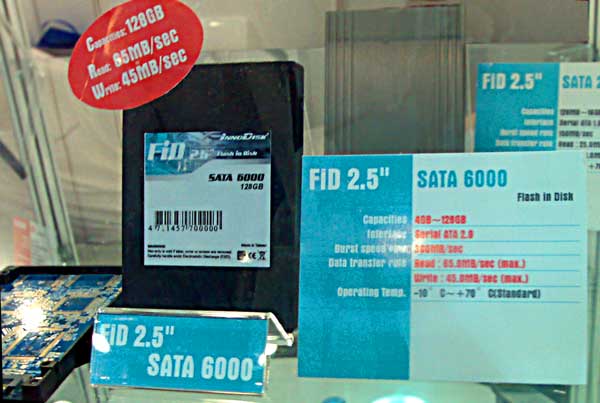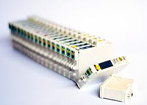 128 gigabyte hard disk drives with no moving parts will be priced below $1000 before the end of this year, says the manufacturer of one of the first solid state drives (SSDs) to hit the market. The flash memory-based drives have numerous advantages over traditional rotating disk drives, including higher speed and much greater reliability, as well as reduced weight, power consumption and temperature.
128 gigabyte hard disk drives with no moving parts will be priced below $1000 before the end of this year, says the manufacturer of one of the first solid state drives (SSDs) to hit the market. The flash memory-based drives have numerous advantages over traditional rotating disk drives, including higher speed and much greater reliability, as well as reduced weight, power consumption and temperature.
“This product's pricing is very strongly related to the flash memory chip price, which is falling continuously,” said Vincent Owyeong, a product manager with flash disk maker, InnoDisk. “The pricing is around $1000 now”.
128GB SSD disk prices below $1000 will come within six months, he predicted. He was speaking at the Computex trade show in Taipei, Taiwan.
Replacement notebook drive
The 2.5-inch drive has a standard serial ATA (SATA) interface and is designed as a drop in replacement for traditional hard disk drives in laptop or desktop PCs.
The drive provides a data read rate of up to 65MB per second and a write rate of up to 45MB per second. The drive has a burst read rate of 300MB per second.

While these continuous data read rates are comparable to traditional drives, the random read rate is approximately 100 times faster. This random access speed is particularly relevant when the drive reads many small or highly fragmented files, or when it attempts to read or write multiple files simultaneously. All these operations would require a old-fashioned hard drive's read head to move repeatedly back and forth across the disk – a relatively time consuming operation.
InnoDisk developed a custom controller chip to provide faster transfer speeds and enhanced error correction in its new series of products, Owyeong said.
Double Windows boot speed
In tests, earlier SSDs have been able to start up Windows XP and Vista at up to twice the speed of traditional hard drives – the high random access speed helps boost this kind of operation. They consume less than 40 percent of the power of a spinning hard drive while operating.
The reliability of flash memory storage has been greatly improved, InnoDisk claims. Older flash memory cells might handle as few as 100,000 read and write cycles before becoming unreliable, giving them a useful lifetime of only a couple of years in heavy use applications. The latest chips are 40 times more durable, said InnoDisk's Vincent Owyeong – they can handle a minimum of 4 million cycles per memory cell.
Paradoxically, the plummeting price of flash memory means that consumers may pay more than they expect for flash-based disk drives, at least until demand increases. Distributors are reluctant to order in large quantities, because flash prices are falling all the time, and unsold stock will lose a significant percentage of its value every month. However, pricing is strongly influenced by volume. For example, while 32GB SSDs have a price around $250, Owyeong said, low demand means consumers are still paying well over $300 for them.
As a result, the main customers for the drives at the moment are applications like industrial and automotive PCs, where, despite the price, their durability and shock resistance are seen as major assets, he said.
256GB drives on the way
While 128GB drives like InnoDisk's are only just becoming available now, some manufacturers have already announced 256GB flash memory drives. Among them is PQI's 256GB SSD Turbo+, which was revealed last week. PQI has not announced details of pricing or availability.










4 million cycles?
I don't understand how you can get 4 million cycles per memory cell. Flash memory is at 100,000 cycles and getting lower for future generations. I think the 4 million cycles should be referring to the system endurance not the memory cell endurance.
No. 4 million writes per cell is within current technology
No. 4 million writes per cell is within current technology.
From www.storagesearch.com: Write endurance: "The typical range today for flash SSDs is from 1 to 5 million. The technology trend has been for this to get better."
From Wikipedia: "Limited write cycles. Typical Flash storage will typically wear out after 100,000-300,000 write cycles, while high endurance Flash storage is often marketed with endurance of 1-5 million write cycles (many log files, file allocation tables, and other commonly used parts of the file system exceed this over the lifetime of a computer). Special file systems or firmware designs can mitigate this problem by spreading writes over the entire device, rather than rewriting files in place."
HDD
Very Good Hard disk